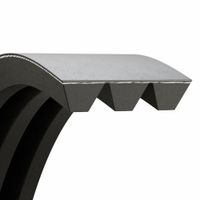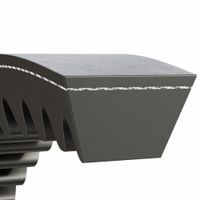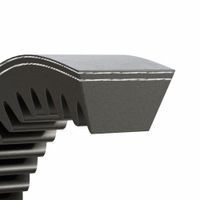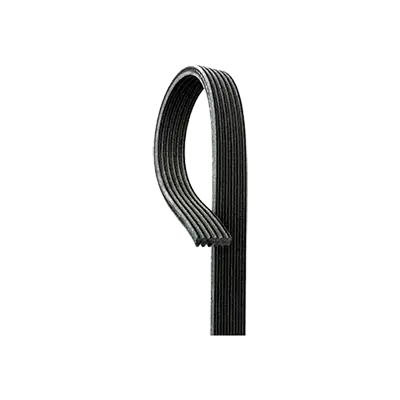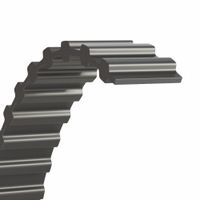Call +(254) 703 030 000 / 751 483 999 / 721 704 777
Vehicle Belts
Vehicle belts mount to pulleys to transmit power from the engine to accessory systems in the vehicle. Cogged V-belts are single belts that have grooves across the width of the belt to help dissipate heat as it runs against the pulley. Banded cogged V-belts are two single V-belts that are fused toget .....Read More
Frequently Asked Questions
What are the differences between cogged V-belts and banded cogged V-belts?
Cogged V-belts and banded cogged V-belts are both used in power transmission systems, but they have distinct differences:
1. **Construction**:
- **Cogged V-belts**: These belts have notches or cogs on the inner side, which allow for better flexibility and heat dissipation. The cogs reduce bending resistance, making them suitable for smaller pulley diameters.
- **Banded Cogged V-belts**: These consist of multiple cogged V-belts joined together by a common backing or band. This banding provides additional stability and prevents the belts from flipping or twisting during operation.
2. **Performance**:
- **Cogged V-belts**: They offer improved efficiency and reduced slippage compared to standard V-belts due to their cogged design. They are ideal for high-speed applications and can handle moderate shock loads.
- **Banded Cogged V-belts**: These belts provide enhanced performance in terms of load distribution and vibration reduction. The banded design ensures uniform tension across all belts, making them suitable for heavy-duty applications with high shock loads.
3. **Applications**:
- **Cogged V-belts**: Commonly used in automotive, agricultural, and industrial machinery where space constraints and smaller pulley diameters are a concern.
- **Banded Cogged V-belts**: Preferred in applications requiring high power transmission and where belt stability is crucial, such as in large industrial machines and heavy equipment.
4. **Advantages**:
- **Cogged V-belts**: Offer better flexibility, reduced heat buildup, and longer lifespan compared to standard V-belts.
- **Banded Cogged V-belts**: Provide superior stability, reduced vibration, and consistent performance under varying loads.
In summary, while both types of belts are designed for efficient power transmission, banded cogged V-belts offer additional stability and are better suited for heavy-duty applications.
How do I know when to replace my vehicle's V-belt?
1. **Visual Inspection**: Check for cracks, fraying, or glazing on the belt's surface. A shiny or glazed appearance indicates wear.
2. **Tension Check**: Press down on the belt. If it deflects more than recommended (usually about 1/2 inch), it may need replacement or adjustment.
3. **Noise**: Listen for squealing or chirping sounds when the engine is running. This can indicate a loose or worn belt.
4. **Age and Mileage**: Replace the belt every 3-4 years or 40,000-60,000 miles, even if it appears in good condition.
5. **Performance Issues**: Notice if accessories like the alternator or power steering are underperforming, as a slipping belt can cause this.
6. **Belt Wear Indicator**: Some vehicles have a built-in indicator that shows when the belt is worn out.
7. **Material Loss**: Look for missing chunks or uneven wear on the belt.
8. **Vibration**: Excessive vibration in the belt can indicate misalignment or wear.
9. **Professional Inspection**: Have a mechanic inspect the belt during regular maintenance checks.
What are the advantages of using micro-ribbed V-belts?
Micro-ribbed V-belts, also known as multi-rib or poly-V belts, offer several advantages:
1. **High Power Transmission**: They can transmit more power than traditional V-belts due to their increased contact surface area with the pulleys.
2. **Compact Design**: Their thin, flexible design allows for use in compact spaces, making them ideal for modern machinery with limited space.
3. **Smooth Operation**: The multiple ribs provide a smooth and quiet operation, reducing vibration and noise compared to single V-belts.
4. **Flexibility**: They can bend around smaller pulleys, allowing for more compact and efficient drive designs.
5. **Reduced Slippage**: The increased contact area reduces the risk of slippage, improving efficiency and performance.
6. **Durability**: Made from high-quality materials, they offer excellent resistance to wear, heat, and oil, leading to a longer lifespan.
7. **Cost-Effective**: Their durability and efficiency can lead to lower maintenance costs and longer intervals between replacements.
8. **Versatility**: Suitable for a wide range of applications, from automotive to industrial machinery, due to their ability to handle varying loads and speeds.
9. **Energy Efficiency**: The reduced slippage and efficient power transmission contribute to lower energy consumption.
10. **Easy Installation**: Their flexibility and design make them easier to install and replace compared to traditional belts.
Overall, micro-ribbed V-belts provide a reliable, efficient, and cost-effective solution for power transmission in various applications.
How do timing belts differ from other types of V-belts?
Timing belts differ from V-belts in several key ways:
1. **Design and Structure**: Timing belts have teeth on their inner surface that mesh with the grooves of a pulley, ensuring precise synchronization between the crankshaft and camshaft in engines. V-belts, on the other hand, have a trapezoidal cross-section and rely on friction to transmit power between pulleys.
2. **Function**: Timing belts are used for applications requiring exact timing and synchronization, such as in internal combustion engines to control the timing of the engine's valves. V-belts are used for general power transmission in various machinery, where precise timing is not critical.
3. **Material**: Timing belts are typically made from rubber with high-tensile fibers like fiberglass or Kevlar for strength and durability. V-belts are usually made from rubber or polymer materials reinforced with fibers, but they focus more on flexibility and grip.
4. **Operation**: Timing belts operate in a closed-loop system and maintain a fixed position relative to the pulleys, ensuring no slippage. V-belts can slip under heavy loads or if not properly tensioned, which can lead to inefficiencies.
5. **Maintenance and Lifespan**: Timing belts require regular inspection and replacement at manufacturer-specified intervals to prevent engine damage. V-belts are generally easier to replace and maintain but may wear out faster due to slippage and friction.
6. **Applications**: Timing belts are primarily used in automotive engines and precision machinery. V-belts are used in a wide range of applications, including automotive, industrial, and agricultural machinery, where high power transmission is needed without precise timing.
7. **Noise and Vibration**: Timing belts tend to operate more quietly and with less vibration compared to V-belts, which can produce noise due to slippage and friction.
What are the signs of a failing vehicle belt?
Signs of a failing vehicle belt include:
1. **Squealing or Chirping Noises**: Unusual noises, especially when starting the engine or during acceleration, can indicate a loose or worn-out belt.
2. **Visible Wear and Tear**: Cracks, fraying, or glazing on the belt surface are clear indicators of wear. A shiny or slick appearance suggests the belt is slipping.
3. **Belt Slippage**: If the belt is slipping off the pulleys, it may be due to improper tension or wear, affecting the performance of connected components.
4. **Engine Overheating**: A failing belt can lead to inadequate operation of the water pump, causing the engine to overheat.
5. **Battery Warning Light**: A malfunctioning belt can affect the alternator, leading to insufficient battery charging and triggering the battery warning light.
6. **Power Steering Issues**: Difficulty in steering or a stiff steering wheel can result from a failing belt affecting the power steering pump.
7. **Air Conditioning Problems**: A failing belt can impair the air conditioning compressor, leading to reduced cooling efficiency.
8. **Vibrations or Shaking**: Excessive vibrations or shaking from the engine compartment can be a sign of a misaligned or damaged belt.
9. **Frequent Belt Adjustments**: If the belt requires frequent tightening or adjustments, it may be nearing the end of its lifespan.
10. **Age and Mileage**: Belts typically have a lifespan of 60,000 to 100,000 miles. If the belt is within this range or older, it may be time for a replacement.
Regular inspection and maintenance are crucial to prevent belt failure, which can lead to more severe engine problems.
How do I choose the right V-belt for my vehicle?
1. **Identify Vehicle Specifications**: Check the vehicle’s manual for specific V-belt requirements, including size, type, and material.
2. **Measure Belt Dimensions**: Measure the existing belt’s length, width, and thickness. If the old belt is unavailable, use a string to measure the path around the pulleys.
3. **Determine Belt Type**: Identify the type of V-belt needed (e.g., classical, narrow, or cogged) based on the vehicle’s requirements and the belt’s application.
4. **Check Load Requirements**: Consider the load and power transmission needs. Heavy-duty applications may require belts with higher tensile strength.
5. **Material Consideration**: Choose a belt made from materials suitable for the operating environment, such as rubber for general use or synthetic materials for high-temperature or oil-resistant applications.
6. **Brand and Quality**: Opt for reputable brands known for durability and performance. Quality belts reduce the risk of premature wear and failure.
7. **Inspect Pulley Condition**: Ensure pulleys are in good condition, as worn or damaged pulleys can affect belt performance and lifespan.
8. **Consult Professionals**: If unsure, consult a mechanic or automotive specialist for recommendations based on the vehicle’s specific needs.
9. **Purchase from Reliable Sources**: Buy from trusted suppliers or dealerships to ensure authenticity and warranty support.
10. **Installation and Tensioning**: Proper installation and tensioning are crucial. Follow the manufacturer’s guidelines to avoid slippage or excessive wear.
By considering these factors, you can select the right V-belt that ensures optimal performance and longevity for your vehicle.
Can I replace a metric cogged V-belt with a standard one?
Yes, you can replace a metric cogged V-belt with a standard one, but there are several factors to consider. Cogged V-belts have notches that provide greater flexibility and better heat dissipation, making them suitable for smaller pulley diameters and high-speed applications. Standard V-belts, on the other hand, are solid and may not perform as efficiently in these conditions.
When replacing a cogged V-belt with a standard one, ensure that the standard belt matches the original in terms of length, width, and profile to maintain proper tension and alignment. The pulley system should be compatible with the standard belt's design to avoid slippage or premature wear.
Consider the operational environment: if the application involves high temperatures or requires high efficiency, a standard V-belt might not perform as well as a cogged one. Additionally, the power transmission capacity of the standard belt should meet or exceed the requirements of the application to prevent overloading.
In summary, while replacement is possible, it is crucial to evaluate the specific requirements of the application and the characteristics of the belts to ensure optimal performance and longevity.
